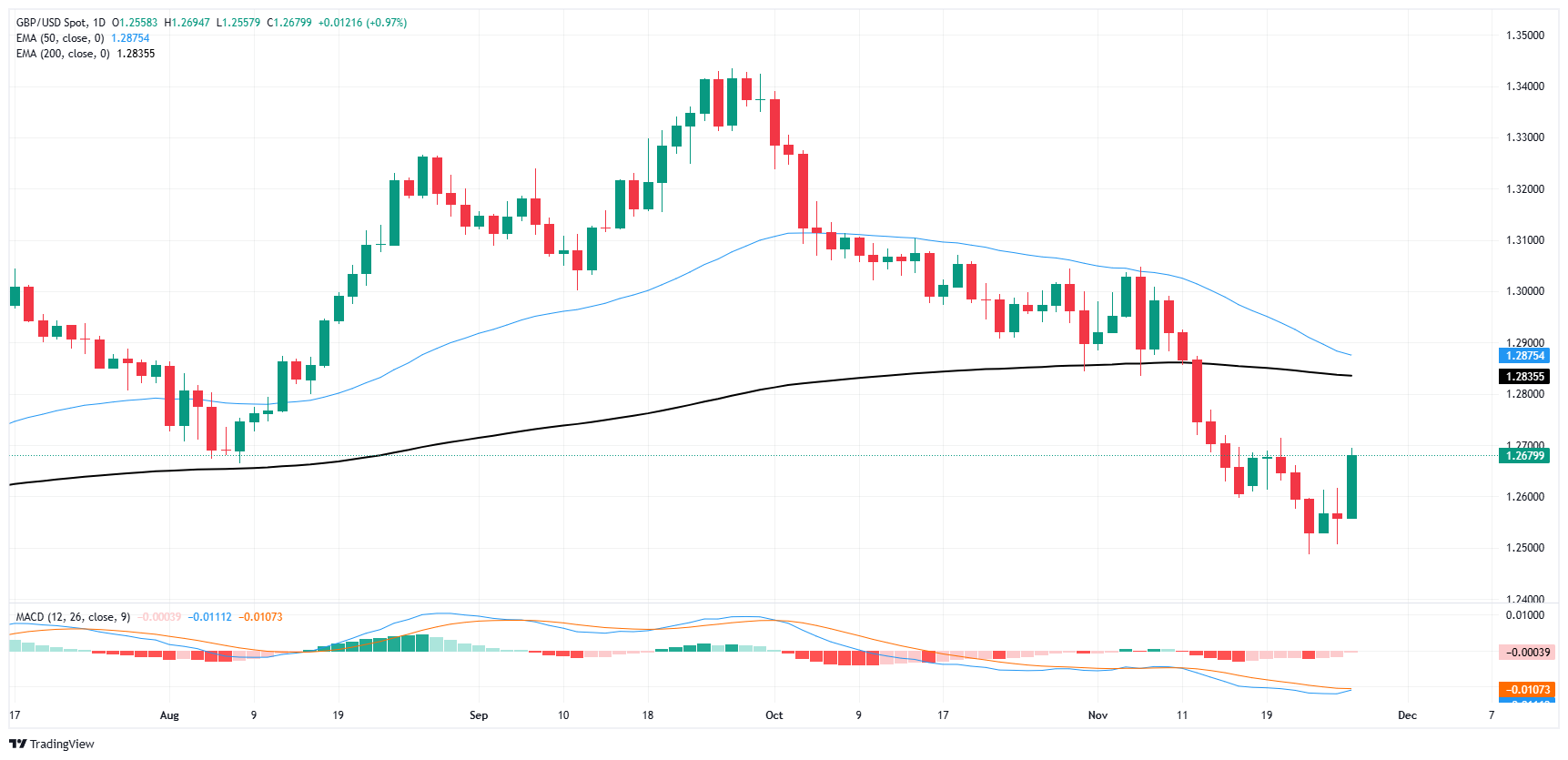- GBP/USD snapped back above the 1.2600 decisively on Wednesday.
- Cable is now bound for a fresh test of 1.2700, but data remains lean.
- A raft of widely-expected US data clears the way for US market holiday.
GBP/USD finally broke back above 1.2600 on Wednesday, propelled higher by a broad-market softening in the Greenback’s recent bullish stance. Economic data remains slim on the UK side of the calendar, and following Wednesday’s broad print of US figures that came in broadly as expected, markets are set for a quiet showing for the rest of the week.
Investors will see a notable constraint on market flows on Thursday and Friday: US markets will be entirely shuttered on Thursday for the US Thanksgiving holiday, and Friday will be light as well with most US exchanges cutting their operating hours short. The UK’s data docket remains equally-thin next week, where investors will be pivoting to face another round of US Nonfarm Payrolls figures next Friday, with plenty of preview employment data to muck up the view.
Annualized US Gross Domestic Product (GDP) grew by the expected 2.8% through the third quarter, to no one's surprise and barely moving the needle on investor pulses. Core Personal Consumption Expenditure Price Index (PCEPI) accelerated to 2.8% for the year ended in October, also meeting expectations. While upticks in inflation metrics generally bode poorly for market expectations of future rate cuts, the move upward was widely expected, and a hold in monthly figures at 0.3% MoM helped to frame the bump in the data as being in the rear-view mirror.
GBP/USD price forecast
Wednesday’s Cable rebound has the pair taking a fresh run at the 1.2700 handle, adding nearly a full percent through the day’s trading and priming GBP/USD bulls for a new leg back into the high side following a 7% top-to-bottom decline from September’s peaks at 1.3434. However, long positioning is set to run into new challenges at the 200-day Exponential Moving Average (EMA) near 1.2835.
GBP/USD daily chart
Canadian Dollar FAQs
The key factors driving the Canadian Dollar (CAD) are the level of interest rates set by the Bank of Canada (BoC), the price of Oil, Canada’s largest export, the health of its economy, inflation and the Trade Balance, which is the difference between the value of Canada’s exports versus its imports. Other factors include market sentiment – whether investors are taking on more risky assets (risk-on) or seeking safe-havens (risk-off) – with risk-on being CAD-positive. As its largest trading partner, the health of the US economy is also a key factor influencing the Canadian Dollar.
The Bank of Canada (BoC) has a significant influence on the Canadian Dollar by setting the level of interest rates that banks can lend to one another. This influences the level of interest rates for everyone. The main goal of the BoC is to maintain inflation at 1-3% by adjusting interest rates up or down. Relatively higher interest rates tend to be positive for the CAD. The Bank of Canada can also use quantitative easing and tightening to influence credit conditions, with the former CAD-negative and the latter CAD-positive.
The price of Oil is a key factor impacting the value of the Canadian Dollar. Petroleum is Canada’s biggest export, so Oil price tends to have an immediate impact on the CAD value. Generally, if Oil price rises CAD also goes up, as aggregate demand for the currency increases. The opposite is the case if the price of Oil falls. Higher Oil prices also tend to result in a greater likelihood of a positive Trade Balance, which is also supportive of the CAD.
While inflation had always traditionally been thought of as a negative factor for a currency since it lowers the value of money, the opposite has actually been the case in modern times with the relaxation of cross-border capital controls. Higher inflation tends to lead central banks to put up interest rates which attracts more capital inflows from global investors seeking a lucrative place to keep their money. This increases demand for the local currency, which in Canada’s case is the Canadian Dollar.
Macroeconomic data releases gauge the health of the economy and can have an impact on the Canadian Dollar. Indicators such as GDP, Manufacturing and Services PMIs, employment, and consumer sentiment surveys can all influence the direction of the CAD. A strong economy is good for the Canadian Dollar. Not only does it attract more foreign investment but it may encourage the Bank of Canada to put up interest rates, leading to a stronger currency. If economic data is weak, however, the CAD is likely to fall.
Information on these pages contains forward-looking statements that involve risks and uncertainties. Markets and instruments profiled on this page are for informational purposes only and should not in any way come across as a recommendation to buy or sell in these assets. You should do your own thorough research before making any investment decisions. FXStreet does not in any way guarantee that this information is free from mistakes, errors, or material misstatements. It also does not guarantee that this information is of a timely nature. Investing in Open Markets involves a great deal of risk, including the loss of all or a portion of your investment, as well as emotional distress. All risks, losses and costs associated with investing, including total loss of principal, are your responsibility. The views and opinions expressed in this article are those of the authors and do not necessarily reflect the official policy or position of FXStreet nor its advertisers. The author will not be held responsible for information that is found at the end of links posted on this page.
If not otherwise explicitly mentioned in the body of the article, at the time of writing, the author has no position in any stock mentioned in this article and no business relationship with any company mentioned. The author has not received compensation for writing this article, other than from FXStreet.
FXStreet and the author do not provide personalized recommendations. The author makes no representations as to the accuracy, completeness, or suitability of this information. FXStreet and the author will not be liable for any errors, omissions or any losses, injuries or damages arising from this information and its display or use. Errors and omissions excepted.
The author and FXStreet are not registered investment advisors and nothing in this article is intended to be investment advice.
Recommended content
Editors’ Picks

AUD/USD bulls remain cautious near 0.6500 amid trade war fears
AUD/USD oscillates around the 0.6500 mark and remains close to a multi-month low touched earlier this week amid worries that Trump's tariff plans will trigger a US-China trade war. That said, bets for a 25 bps Fed rate cut in December and the recent fall in the US bond yields keep the USD depressed near a two-week low, offering some support to the Aussie.

USD/JPY recovers from over one-month low; upside seems limited
USD/JPY attracts some buyers during the Asian session and moves away from over a one-month low touched on Wednesday, though any meaningful recovery seems elusive. Worries about the economic impact of Trump's pledged tariffs and geopolitical risks continue to underpin the safe-haven JPY.

Gold price holds steady below $2,640 as traders seem non-committed
Gold price consolidates after the overnight pullback from the vicinity of the $2,660 level. Trade war fears, geopolitical risks, bets for another 25 bps Fed rate cut in December, the recent fall in the US bond yields and the overnight USD slump to a two-week low act as a tailwind for the XAU/USD.

Ripple's XRP eyes rally to $2.58 as whales step up buying pressure
Ripple's XRP rallied 6% on Wednesday following increased buying pressure among whales in the past two weeks. The remittance-based token could stage a move to $2.58 amid increased institutional interest in the launch of an XRP exchange-traded fund (ETF) in the US.

Eurozone PMI sounds the alarm about growth once more
The composite PMI dropped from 50 to 48.1, once more stressing growth concerns for the eurozone. Hard data has actually come in better than expected recently – so ahead of the December meeting, the ECB has to figure out whether this is the PMI crying wolf or whether it should take this signal seriously. We think it’s the latter.

Best Forex Brokers with Low Spreads
VERIFIED Low spreads are crucial for reducing trading costs. Explore top Forex brokers offering competitive spreads and high leverage. Compare options for EUR/USD, GBP/USD, USD/JPY, and Gold.